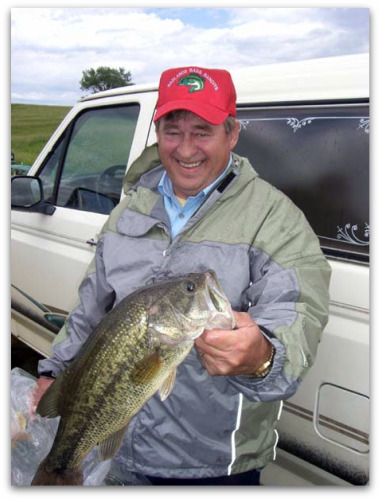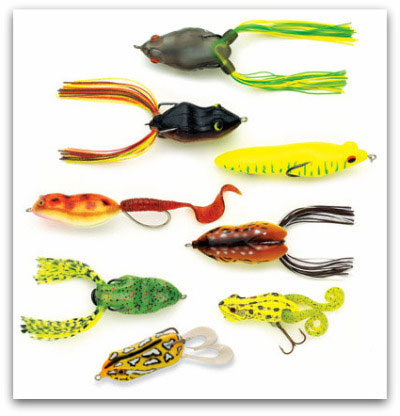Bass On Top

By Terry Piper
Nothing in the sport of bass fishing can compare to the joy and excitement of catching bass on topwater baits. One minute you are watching your lure come across the surface (slow or fast depending on what you are using) and the next second it disappears and the water explodes where your bait used to be. Your heart pounds and you set the hook. The bass leaps into the air, shaking its head from side to side, trying to spit out your lure. Welcome to ‘Bass on Top’.
There are a variety of topwater lures out there. Which one you choose, depends entirely on the conditions you are fishing in. My passion is a topwater frog, and that’s what I’m going to talk about here today. There are many different styles of frogs out there. Some have legs that wobble; some have a ‘skirt’ (like a spinner bait skirt) on them. Which style you like best will have to be decided after trying them.
My favorite frog is the ‘Scum Frog Popper’, made by the Southern Lure Co. This model comes in a variety of colors. It is about 1 ½” long, with a skirt for legs, and a double hook that lays on top of the back of the frog, making it almost totally weedless. The front of the lure is concaved, and can be twitched or jerked, to pop and splash the water. The body is hollow and soft and collapsible.
When a bass clamps down on it, there is almost no resistance to the bite. (When using a bait like this, you have to train yourself to wait a second or so after the strike, to set the hook. If your reactions are fast and you try setting the hook by the sight of what you see, you will miss a lot of fish. Even the pros will admit they often have a problem with this.) The places to use this bait are extensive. It is not just a lure to throw in the weeds. I have brought up fish in clear water, from depths of six to eight feet, after it. Cast it under a dock or past the dock and bump it off the dock posts as you retrieve it. Throw it in the shade of an overhanging tree or the shade of a boat or pontoon. Try throwing it as close to shore as you can, and work it back towards you. Reel it in and cast again when you feel you are no longer in striking waters. Then comes the most exciting presentation of all, cast the bait into the worst junk you can find. Especially Lilly Pads with some space between them. Cast out, pull it off a pad slowly and let it drop in a hole between the pads. Let it set for a couple of seconds. Twitch it or ‘pop’ it. Let it set again. Continue this action all the way back to the boat. Fisherman beware, when you least expect it, a bass will bust threw the Lilly Pads to get your frog.

To fish like this, you need a good heavy or at least medium heavy 7’ to 7’6” rod. (I use 50 lb. test Spider Wire for line. This, along with the heavy rod, gives me the capability of pulling my bass out of the pads without them breaking me off.) When fishing in the pads like this, keep your rod tip up. This will help to keep your line from sinking under the pads between you and your lure. (This can be hard to do on a windy day.) If your trolling motor will allow you to go right into the pads, do so.
If you are by yourself, fan cast around your entire boat before moving (or all of one side if you need to share space with a partner and give him the other side). Go beyond the range of where you were, and start all over again. If you are outside the pads, make sure you pop your frog a few times and leave it set on the outside edge. Many times bass are laying under these pads, waiting for something to come by. Pads provide great shade with cooler water, as well as a good place to attack from. Pads that are so tight together you cannot get your bait into any water around them are almost impossible to fish. Move on. If pads are not available or you’re not having any luck in them, look for Bull Rushes or Pencil Reeds. Position your boat so that you can cast with the wind if possible. If the rushes are sparse and you can cast straight into them, this works well. You want to fish in about 1’ to 4’ of water. Use the stop & pop method here also. This area is really good right at daylight and for awhile before sunset. Expect to catch some really nice fish this way. Lastly, look for vegetation that is lying on top of the water (just about any kind). Cast past it if possible and work over the top of it slowly. Stop if you find a hole in it. Pop it a couple of times and wait. If a bass doesn’t smash it, continue on. Make sure you let it set for awhile when you reach the outside edge. Many times a bass has followed the movement caused by your lure and will attack it when it gets out in the open.
Don’t expect to do all this perfect the first few times you try it. It takes time to learn to cast where you want to go, learn when to set the hook, and especially where the best choice is for where a big bass is waiting for your frog. When all this falls in place, you’ll have some of the most exciting fishing you ever done.
Terry Piper
-Badlands Bass Bandits Member



